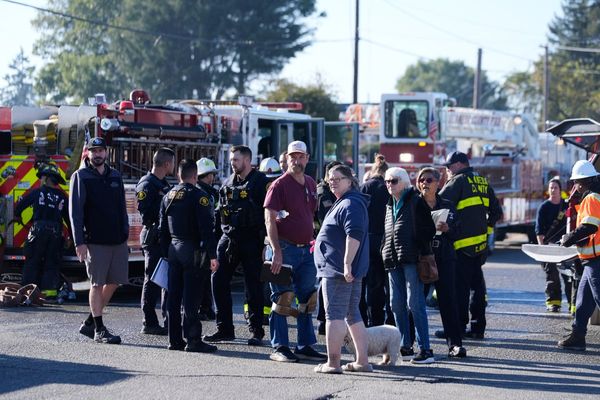
“If we’re going to see koalas today, it will be in the next few hundred metres,” my guide calls to me as we tackle stage two of the Clare Valley wine and wilderness trail.
So far, flame robins have licked the trees just in front of us, galahs have shrieked to mark our arrival in otherwise serene clearings, and roos have skipped away, barely snapping a twig.
There are no koalas but, before long, we have managed to sneak up on a winery. It comes with barely a warning, out of the bush, and before we know it we’ve been relieved of our packs and are enjoying Jeanneret’s finest riesling from the deck.
There will come a time on the trail, perhaps after a sip of riesling or a bite of something particularly delicious, when you will question if it only tastes that satisfying because you had to walk to get it. After all, even a squashed muesli bar and a swig from a water bottle is sumptuous after a decent trek. But the answer to this question is mostly no; what you are consuming really is that good, walking or not.
The Clare Valley trail was completed last year. A Covid project led by Michael Nugent and Tim Grigg, it was driven by a wider community group who maintain the path on a voluntary basis.
It loops about 100km around the perimeter of the valley, as well as taking in other valleys running parallel to the Clare. Along the track, there’s not just wine but breweries, distilleries and towns, the largest of which is Clare. It takes six days to walk its length.
The walking is mostly moderate – I had hiking boots but trail shoes or even runners would also be OK – with a few tougher climbs. It is also wonderfully quiet. I only saw one other group of five my entire three mornings on the track, although the wineries I visited almost all hummed with people in the school holidays (and the week after AFL gather round).
After walking to Jeanneret on stage two – taking in South Australia’s only stand of red stringybark, the westernmost in the country – we continued a little longer for lunch at Skillogalee.
This walk of less than 2km between vineyards is one of several shorter walks that can be cleaved off from the trail, for those keen for a taste without committing to an entire morning, or more, of hiking.
The next day I tackled part of stage six, walking from just outside the Sevenhill hotel to Pikes cellar door.
The track covers both public and private land, including fire trails and road reservations. It involves clambering over iron-red stiles – many of them made by a local men’s shed.
Walking through other people’s properties and climbing over fences can give the sense you are being a little naughty; are you going to taste this wine or steal it?
On foot, it is easier to appreciate the landscape that makes Clare Valley wines highly awarded. You can sense how the valley’s shape creates pockets of microclimate, and how the geology can change markedly from slate to limestone and quartz, over short distances.
This helps when you settle in somewhere like Pikes cellar door. With a dizzying list of wines to try, you can limit it to vineyards you’ve just walked past.
As I walk, there is no escaping that the Clare is experiencing a severe drought. Several people apologise to me for how dry it is.
Tim Adams, who has made wine in the region for 50 years, reckons he’s never seen it drier. I spent my final day walking a slightly modified part of stage one, which took in Adams’ cellar door and lunch at his restaurant in Clare, Mr Micks. In between, we trek through Hill River Station, and along a ridge which affords views across Clare Valley. It may be dry, but it is still majestic.
Food and drink
The region is especially known for riesling and cabernet sauvignon, and most wineries will have multiple versions of both.
My standouts were Jeanneret, Pikes and Tim Adams (for tastings, all three require bookings). Pauletts and Skillogalee also had great wine, and dégustation and à la carte menus. The Penobscot Restaurant at the Watervale hotel is the fanciest dining option in the valley but there are great cheap places too, including at the Clare Rise and Little Red Grape bakeries in Clare and Sevenhill. Sevenhill hotel also serves excellent pub food (try to get a table in the cellar). Most wineries will happily help you arrange freight of your wine, as will Clare’s tourist information centre.
Accommodation
Clare is the biggest town in the region and there are multiple options here, from the caravan park (from $30 for a powered tent site and $148 for a one-bedroom cabin) to self-contained apartments (from $330 a night). There are other options in semi-rural settings, including Neagles Retreat Villas (from $360 a night) and tiny homes at CABN Clare Valley ($330 a night) . There’s also free camping in the car park across from the Watervale.
Logistics
Clare Valley Walk offers multiple packages for people keen to do the full hike, either guided or by themselves, including accommodation and dining options. A three-day, two-night package including food, transit and accommodation starts at $670 a person. I set out between 9am and 10am each morning and reached each winery in time for lunch but in warmer months you could start earlier, leaving more time for wine.
To do the multi-day hike without a guide service, you will need a car or alternative transport arrangements (taxis are available in the region, with Uber also expected to launch soon). The cheapest way to do it would be with a companion, by parking a car at the end of each day’s leg, then travelling together to the start in a second car.
A camping ground on the trail is expected to open soon, with more to follow.
Day walks
All six stages of the walk are achievable in a day each but there are lots of ways to shorten stages, or to get a taste of the walk without forgoing too much wine time.
You could modify stage one by starting near Farrell Flat Road, walking along the ridge, down to Tim Adams Wines, and then on to the newly opened Clare Valley Distillery (making it closer to 7km than 21km).
I also loved the modified stage six walk, which almost halves the length by leaving from Sevenhill hotel and ending at Pauletts (you can extend further by also detouring to Pikes), and the final third of stage two, which went through the Spring Gully conservation park after starting at the Blue Gum lookout, and ended at Skillogalee via Jeanneret.
Guardian Australia travelled to Clare Valley courtesy of South Australian Tourism Commission







